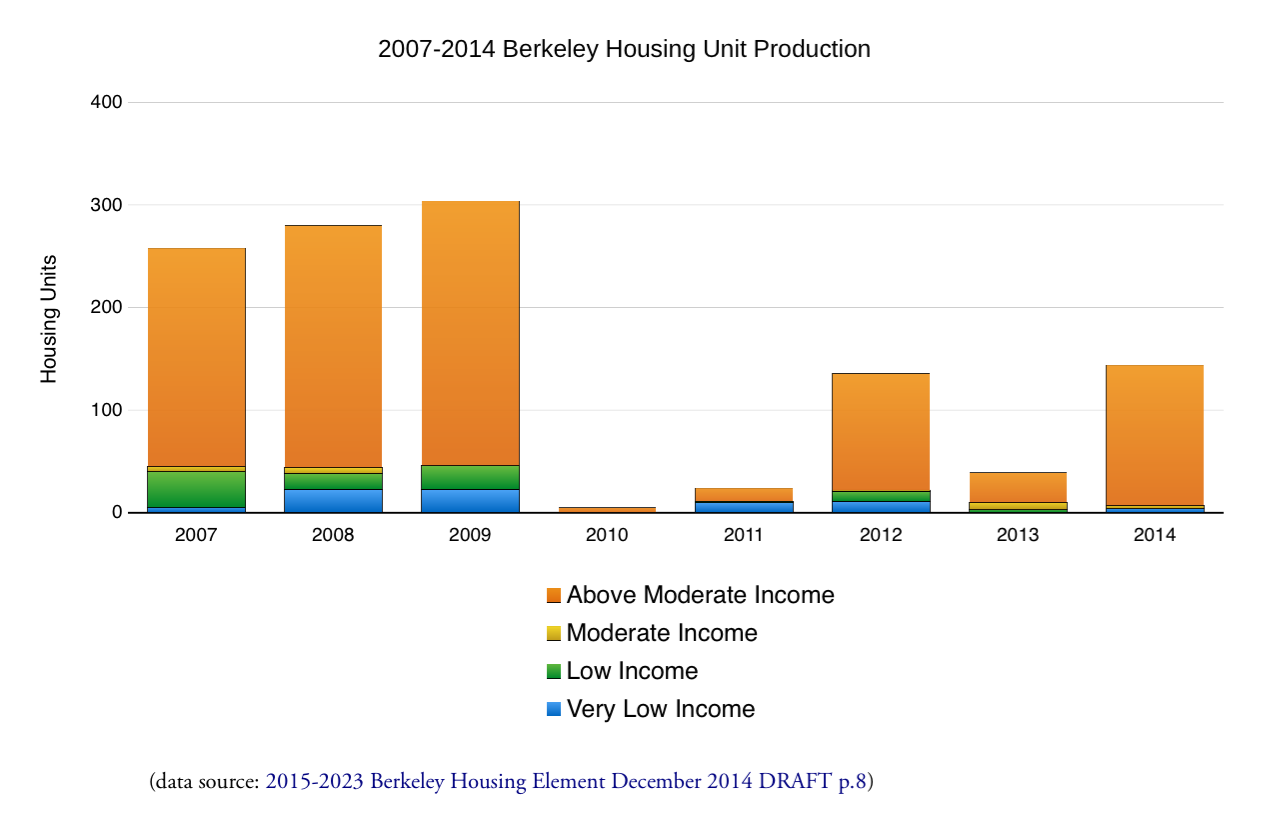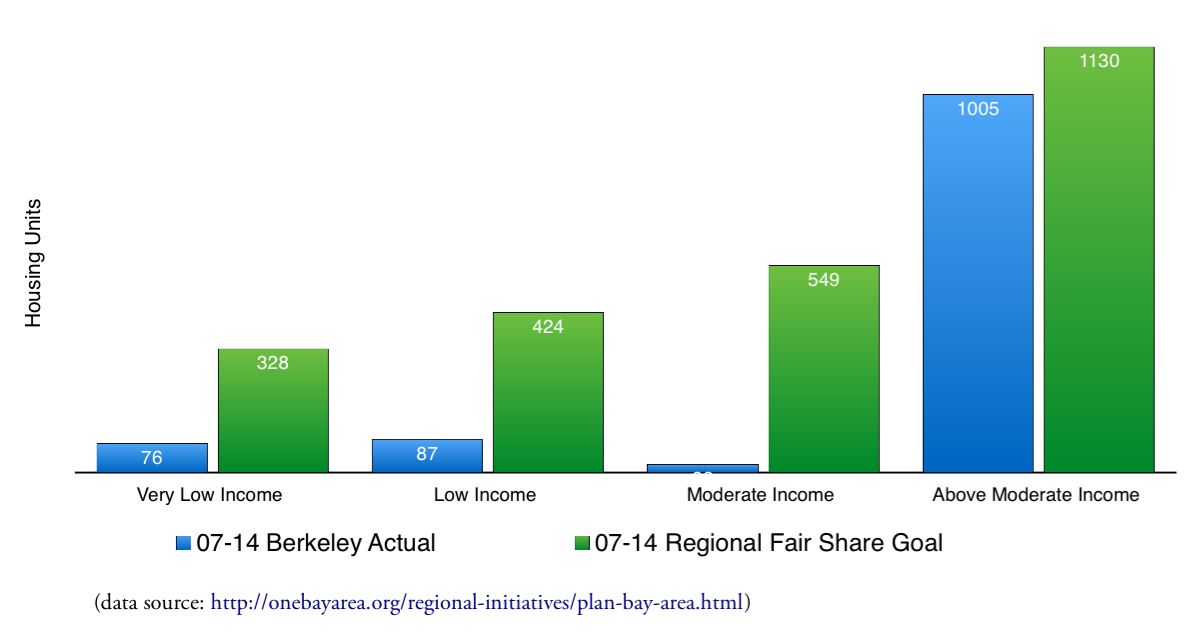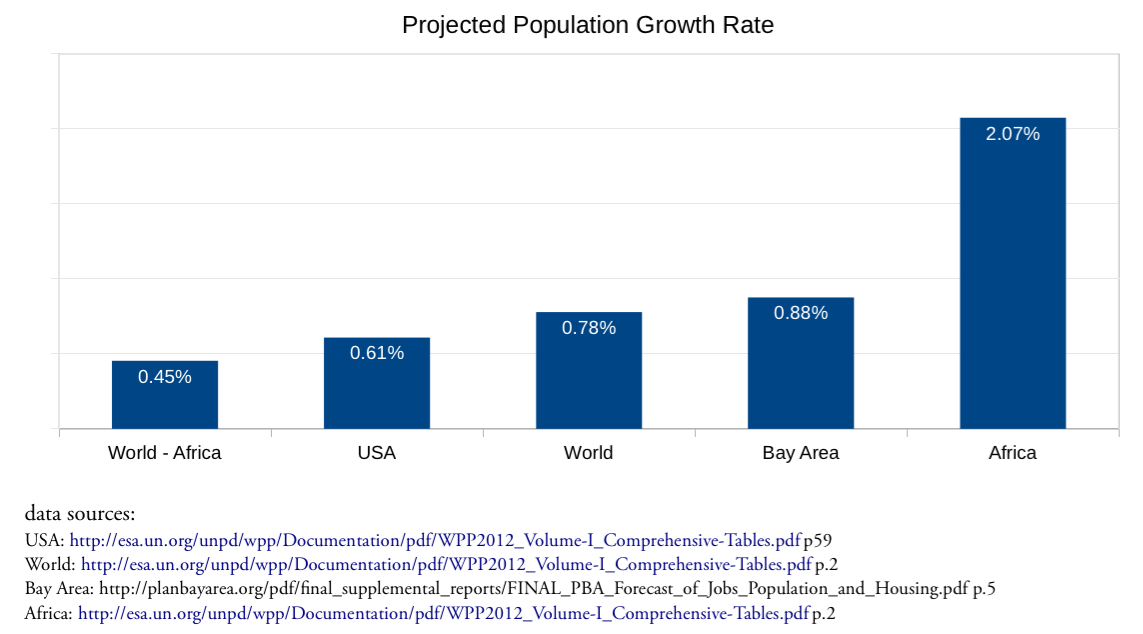Readers must be as tired as I am of land use, land use, land use for the last few weeks. But here’s the thing: In this crazy economic world, the extremely rich, also known as the 1%, are at the moment burdened with extra capital which they need a place to park. That’s why we’re having a boom in construction of the luxury apartments which is now irrevocably altering the face of cities formerly famous for their charm. It’s been happening for a while in San Francisco.
For a complete examination of how it’s come down there, see the analytic journalism of Joseph Smooke and Dyan Ruiz at peoplepowerjournalism.net. New York City’s luxury dwellings are in a class by themselves, as recently documented in the New York Review of Books and elsewhere. London, Paris, Shanghai, you name it, real estate speculators are building glamorous high-rise pieds à terre to sell to the super-rich from all over the globe.
And now they’re coming to Berkeley. Soon. Not long ago, the development industry bought themselves a couple of Berkeley elections which had very poor voter participation. Measure R 1.0 promised everything except free apple pie to gullible greenish voters, notably without specifics. Some of those were filled in later by Mayor Tom Bates and his City Council majority. The centerpiece was their provision in Berkeley’s downtown plan for five extra-tall buildings, three private and two for U.C Berkeley, for developers who promised to provide “significant community benefits”, the meaning of which deliberately was left very vague, essentially undefined.
The most recent Measure R 2.0 ballot initiative was a poorly conceived though well-intentioned effort to fill in the blanks. This time developers outspent proponents by a factor of 10-1, and no surprise, they won, though not by any 10-1 margin, in an election with another record low turnout by confused voters.
Highrise Number One (no news to any regular reader of this space) is slouching toward Berkeley, ready to be born. That would be the now notorious 2211 Harold Way, named by its side street address to disguise the fact that developers plan to take out almost a whole block of thriving Shattuck Avenue restaurants, retail and worst of all, the 10-screen Landmark Shattuck Cinemas to create a site for their tower.
Yes, yes, promises, promises are being thrown around, but anyone who’s been around a Berkeley block more than once can recognize the old “vanishing cultural icon” trick.
(Watch my hands! At no time do my hands leave my wrists—and yet: The Lady Vanishes!)
The first of these I can almost remember was a theater called, if fading memory serves, the Spice Box—the bait for gentrification of the historic Durkee spice factory when it housed an artists’ colony in West Berkeley. To make a very long and shocking story short, the lovely theater was eventually illegally demolished by the property owners— but the development, of course, endures. The city of Berkeley refused to enforce the agreement which went with the permits in court after the demolition.
A local wag says that if you want the name of your business to live forever, sell your property to a developer, especially to Patrick Kennedy. The business will die of course, but the name will live on. That would be, e.g., the Gaia Bookstore, which never opened as promised in Kennedy’s Gaia Building, and also the Fine Arts Theater, which survives only as a faux marquee on an apartment building which you can see today on Shattuck across from the site of the proposed "Residences at Berkeley Plaza". They are two of many cultural icons which have been used in the bait-and-switch routine—too many to list here.
Now a new scheme has surfaced. There seems to be a proposal being floated behind the scenes by Tom Bates and his associates to sweeten the Harold Way deal with talk of a performing arts center in the new building.
Here’s the foreground story: Tuesday’s Berkeley City Council meeting was ably reported by Tom Lochner in the Contra Costa Times. He picked up the main points of the public story of this project in good form, and rather than recounting them myself I urge you to click on the link above and read it.
But what Lochner missed, the kind of thing it’s hard for a daily reporter on deadline to absorb, was the back story. Agenda Item 37 was listed as a discussion of what might constitute “significant community benefits” for 2211 Harold Way and its four successor high-rises. Fans of the threatened Landmark Shattuck Cinemas turned out in force to urge their preservation, myself among them.
In the hall before the meeting I recognized a bunch of people I know as active participants in the Berkeley arts scene, of which I am an enthusiastic patron, and I wondered why they were there.
As the meeting got underway, there was an announcement that since Item 37 was very late on the agenda, the council would hold an additional special meeting on the benefits question alone on May 5, so most of those who’d come planning to speak went home.
Among the remaining speakers was someone I’d met before, Jennifer Boesing, who runs the Youth Musical Theater Company (YMTC). She spoke on behalf of what she called “a fairly informal but growing consortium of live performing arts groups.” She said they’d been talking about a performing arts center being included in this new development as part of the community benefits, and she gave the council a handout which she said they had seen before (though it was not included in their packet.)
The arts group’s plan was described as a 400-seat theater plus a 4-5 screen film theater, perhaps run by other operators if Landmark Cinemas wouldn’t agree to participate. Other speakers endorsed her plan,
The next day I managed to obtain a copy of the proposal, and I called Jen to ask for more information. She told me that she’d been approached by one of her board members with the idea.
And here’s where things started to look a bit skimey.
That YMTC board member who approached her turned out to be Denise Pinkston, listed on their website as "a partner with TMG Partners, a real estate development firm in San Francisco", who, Jen Boesing told me enthusiastically in a hurried phone call, was also the Mayor’s appointee to the Zoning Adjustment Board. In fact Jen spoke of “The Mayor’s Plan”, and she said she’d already talked about it to “almost all” of the councilmembers, including someone on the Mayor's staff if not the Mayor himself.
(Let’s put aside here for the moment the distraction of the state Brown Act’s prohibition of “serial meetings” in private with government decision-makers, which sounds a lot like this series of meetings . I haven’t checked with all parties to ask what actually went down, so we’ll let it lie.)
As it happens, I was present at the ZAB meeting in January when Pinkston, without disclosing her YMTC connection, argued forcefully for replacing the Landmark Shattuck Cinema's 10-screens with a more amorphous general use performing space. That was also the meeting where commissioners discussed what they ultimately did at a later meeting, kicking the undefined question of significant community benefits up to the City Council.
Boesing also told me that the unfortunately named Berkeley Cultural Trust (described on its Facebook page as “ a consortium of individuals representing cultural organizations within the City of Berkeley” ) had met with someone from the Mayor’s office who talked to them in much more detail about the prospect of including a performing arts center as a sweetener in the Harold way highrise deal.
Now we get into the gory detail, just when many readers have probably fallen asleep. The mayor’s man on the cultural scene at that meeting was Gregory Magofna. Just last week, the Planet discovered that Magofna was also an advocate for (and probable member of) “San Francisco BARF”, a lobbying group which pushes building as much as possible everywhere all the time, using the wildly misconstrued conservative supply-side doctrine that luxury apartments will somehow trickle down to provide affordable and even low-income housing. They claim not to be funded by developers...
He wrote this to SFBARF’s Google Group before Tuesday’s council meeting:
“I know a special Berkeley sub-group was created upon my request, I will get to that with specific projects in the coming weeks. I just wanted to let the group know about something on tonight's city council agenda: Significant community benefits for developments over 75 ft in Downtown Berkeley. The fight is over what else developers should be required to do and NIMBYs have been making outrageously impossible demands to meet to block the project. There is talk of another meeting coming up just on this so it's not the end of the world if no one attends, but it does set the stage for the other 4 tall buildings in downtown. Please plan on coming to the special meeting in May."
And on December 5, 2014, Magofna cast the only "No" vote on the Housing Advisory Commission on a motion that said "…the HAC strongly believes that the new high rises in the Downtown must also provide additional affordable housing benefits, in addition to other proposed community benefits,…"
Berkeley’s Mayor, the City Council and the Zoning Adjustment Board are supposed to sit in judgement on whether or not a proposed beneficiary of the Downtown Plan’s provision for added height will provide significant community benefits in return for the concessions they’re granted. So what's the Mayor doing lobbying himself and his council for a particular proposal, most especially with the help of a city-paid staffer who seems to have divided loyalties?
Don’t get me wrong. I’m a big fan of live performance, especially opera, which is one of the components of the proposal. But I’m also a fan of open and democratic decision-making, and so far this process looks pretty fishy to me, through no fault of the somewhat naïve arts organizations.
I have two concerns. First, I’m sure that Berkeley is seriously over-built with high-end housing, and profoundly undersupplied with affordable and low-income housing. “The Residences at Berkeley Plaza” will just make that situation worse.
Jen Boesing told me yesterday that the Mayor has “a big pot of money” to draw on when community benefits are handed out. In her speech to Council on Tuesday she acknowledged the need for affordable housing.
I’ve been wondering why in recent council meetings the Mayor , seeming nervous, has suddenly been trying to fast-track his version the “1% for the arts” ordinance that’s been standard in many other cities for decades. Now I realize that’s supposed to be the foundation for his “big pot of money.”
And yet, isn’t affordable housing of some sort required to be provided when new buildings like these are built? Yes, to oversimplify here, under both state and local law either a certain number of “affordable” (weasel-word alert) units must be included on-site, or a per-unit fee must be paid into our Housing Trust Fund in lieu of such inclusionary units.
Berkeley’s in-lieu fee is astoundingly low: $20,000 per unit, which won’t buy, as they say in the trade, bupkes in the way of affordable housing. By comparison, San Jose extracts something like $120,000 from developers, though they’re currently facing a right-wing lawsuit over the concept of inclusionary zoning.
Berkeley’s current fee was discounted by the council, back when the economy was in deep trouble, from the statutory $28,000 (still bupkes). On Tuesday the three progressive councilmembers attempted to restore the full amount, but they lost to the typical six-vote Mayor’s majority.
Why might that be? It’s that pot of money.
A conspiracy theorist might suspect that the Mayor’s office has been busy behind the scenes haggling with the developer’s front man, Mark Rhoades, formerly a manager in the city’s Planning Department. You can’t raise the in-lieu housing fee without taking money from the honey pot that could be used to sweeten the approval process, if the developer will only agree to provide a limited amount of honey.
Which brings me to my second concern: I remember only too well Berkeley’s long series of bait-and-switch developments, only a few of which are outlined above, in which arts venues were used as bait and then evaporated.
We could be seeing, once again, the old “vanishing cultural icon” trick in progress. The arts groups, in all good faith, may be the marks this time.
You’ve got to keep your eyes on the magician’s hands, if you care what happens to downtown Berkeley.
The last word on this topic should go to two councilmembers who are valiantly trying to do just that.
Kriss Worthington and Max Anderson deftly framed the problem on Tuesday:
KRISS WORTHINGTON: “Basically the City of Berkeley has changed our laws to allow hundreds of thousands of dollars and potentially millions of dollars of additional profit to be made by corporations that are building major developments... At the time that we did that, we left it vague and confusing to the public and to the zoning board…The city is giving these corporations, certainly cumulatively millions of dollars of profit, and what is the city getting in return? What are the people of Berkeley getting in return? That's what "significant community benefits" is really all about:
The city did not require what I advocated in terms of protections for labor, for the people who work in the buildings, for the people who are building the buildings.
The city didn't include the environmental protections that should be there, or the transit…
And we certainly didn't require the affordable housing that is desperately needed in our city. So now is our chance to go back and right the mistakes that were made at that time and actually have policies that give clarity.
To me the top priorities are:
- addressing affordable housing,
- addressing the issues of the people building the buildings, and
- addressing the multiple environmental issues.
We really need to keep this in mind: We changed the law to give these folks millions of dollars. And the question is: Is the public going to get anything back? MAX ANDERSON: Along those lines, I would like to introduce a novel concept. When a project is being proposed and we are looking at their applications and permits and their financials, we get one peek at what they present us in terms of financials.
To me the concept of community benefits is linked to how much profit these corporations are making at the expense of impacts on the city. We never know how much they make. I think we need to find out how much they are making. Because if we can link that to the impacts and the costs of those impacts on the community, I think we can make a powerful argument.
But the city doesn't follow up on that. Once we issue the permits, give the enhancements to the property, increase the value of it, the profitability of it for the developer or corporation, they ride off into the sunset toward Bank of America and we never see what they got.
All we are left with is what the impacts were, most of which are very poorly mitigated. That's my idea.”
What are developers getting from Berkeley, and what does Berkeley need in return? Those are indeed the questions we need to have answered.
This week the public will have a chance to think about what significant benefits should be and how to calculate the true profit on developments at two hastily convened public gatherings. The first is a “Community Workshop” which Berkeley City Councilmember Jesse Arreguín, representing District 4, including Downtown Berkeley,and Berkeley Zoning Adjustments Board members Sophie Hahn and Shoshana O'Keefe are hosting on Wednesday, April 15, from 7:00 p.m. to 9:00 p.m.
Their announced purpose: to help develop a way to identify significant community benefits from new downtown high-rises. They note that: “This workshop is to consider a general framework for Community Benefits, not specific projects. Councilmember Arreguin and Boardmembers Hahn and O’Keefe vote on projects in a quasi-judicial capacity, and therefore cannot discuss specific projects.”
The location is the Fireside Room of Live Oak Park Community Center, 1301 Shattuck Avenue at Berryman.
The second is an informational meeting which I had a part in organizing, billed as a “Teach-In on Berkeley Development and Affordable Housing”, co-sponsored by Berkeley Citizens Action, Berkeley Neighborhoods Council and the Coalition for a Sustainable Berkeley.
San Francisco journalists and activists Smooke and Ruiz will provide the keynote talk for the event and other speakers will include Rob Wrenn, former member of the Planning Commission and Downtown Area Plan Advisory Committee, Steve Finacom, past President of the Berkeley Historical Society, and Tom Hunt, former member of the Berkeley Transportation Commission.
This one will take place on Saturday, April 18, at 2 p.m. at the Berkeley Arts Festival space, 2133 University Avenue.





